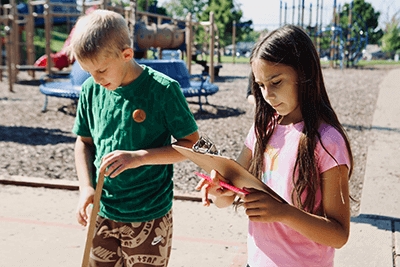November 7, 2024
 from Dr. Bill Hudson, head of school
from Dr. Bill Hudson, head of school
With a joyful spirit, MPA students went to the polls on election day. The library was transformed into a bustling polling place, with ballots, voting booths, and older students assisting younger ones. Lower School students had fun voting for spirit wear options or “express yourself” clothing on monthly out-of-uniform Fridays, while Middle and Upper School students participated in the presidential vote. Witnessing our students actively engage in this democratic practice was both heartwarming and hopeful, and I am deeply grateful to everyone who contributed to this meaningful event.
This mock election was part of a larger, month-long focus on civic engagement and civil discourse at MPA. Throughout the fall, we’ve committed to enhancing a culture where students learn to engage thoughtfully, respect diverse perspectives, and analyze information critically. Grounded in MPA’s founding principles and John Dewey’s philosophy of experiential learning, our mission-driven goal has always been to empower students to become well-informed, active participants in society. The Election 2024 Plan, led by teachers Summer McCall and Katie Murr, offered students a variety of opportunities to explore civic engagement, from age-appropriate discussions to civil discourse training, all designed to prepare them for constructive, thoughtful conversations.
The excitement of Tuesday gave way Wednesday to a range of emotions throughout the school as the results of the national election became known. Developmentally, students responded to the news in a variety of ways and teachers were prepared to accompany and support them however they were feeling. We were prepared to offer safe spaces for students to come together to process the election outcome and to address and call out when students were not respectful of one another. I know teachers worked hard yesterday (and will continue) to make sure that every student had a chance to say what they are thinking and feeling while also being aware of the impact their words have on others.
 from Jennifer Le Varge, Lower School director and director of the Center for Inclusive Teaching and Learning
from Jennifer Le Varge, Lower School director and director of the Center for Inclusive Teaching and Learning  from Dr. Bill Hudson, head of school
from Dr. Bill Hudson, head of school This message is from MPA’s Office of Admission from the October 26 issue of Inside MPA.
This message is from MPA’s Office of Admission from the October 26 issue of Inside MPA.  from Dr. Bill Hudson, head of school
from Dr. Bill Hudson, head of school
 from Dr. Bill Hudson, head of school
from Dr. Bill Hudson, head of school from Dr. Bill Hudson, head of school
from Dr. Bill Hudson, head of school from Dr. Bill Hudson, head of school
from Dr. Bill Hudson, head of school from Dr. Bill Hudson, head of school
from Dr. Bill Hudson, head of school